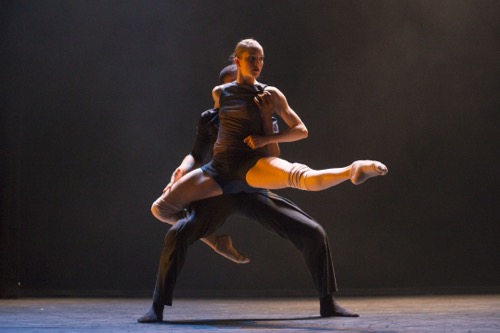
by 2014 International Commissioning Project choreographer Ihsan Rustem. Photo by Todd Rosenberg.
As a dancer, I spend my entire day in socks. They are my preferred footwear — my dance shoes, my ballet slippers, my performance-wear, my fashion statement, my secret weapon. With only one exception (Alejandro Cerrudo’s Lickety-Split), all of the repertory I have performed onstage with Hubbard Street 2 has either been in calf-height socks that neatly match the rest of the costume, or ankle-height socks that match my skin tone. The latter look has been dubbed by some as “the Hubbard Street sock,” but it’s not just this company that performs in stocking feet. Most contemporary dance shows I’ve been to in the past six years have been performed either barefoot or in socks — a phenomenon I’ve come to understand and love, but which also elicits from the audience questions like, “Why are the dancers wearing socks? Are they in their pajamas? Where are their shoes?” Hopefully by sharing my passion for this form of footwear I can debunk and demystify the all-important Contemporary Dance Sock.
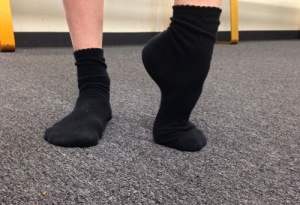
The first time I danced in socks was in 2009 at the San Francisco Conservatory of Dance. We were working with Alessio Silvestrin from The Forsythe Company, and without fail he wore socks over ballet shoes in every rehearsal. Coming from a ballet background, this was a new concept to me. I knew it was trendy to wear socks over ballet shoes in order to warm your feet faster for the first combinations at the barre, but I had no idea that in contemporary dance, people actually wore socks onstage in performance. Being the dutiful student I was, I tried to copy Alessio’s look, but I didn’t yet fully grasp the art of dancing in socks. I tried out all kinds in rehearsals: crew-cut athletic socks, calf-height socks of all synthetic blends, those plush fuzzy socks that are great in the wintertime, warm slipper-socks with rubber grips on the bottoms. When so many sock varieties failed to satisfy me I tried keeping my ballet shoes on and danced barefoot a few times, but soon realized that most contemporary choreography really works best in socks.
My friend Carson Stein (now a dancer with Liss Fain Dance and Sharp & Fine in San Francisco) tipped me off to the most important factor of sockage in dance: high cotton content. Synthetic blends had me slipping all over the place. Thick, fuzzy socks tended to stick more to the floor than to my feet, and my poor toes were swimming inside with all the extra room. Athletic socks worked alright, but I soon found that I was bothered by all the extra padding underneath certain parts of my feet and wanted to be able to feel my own skin nearly on the floor, but with a thin layer in between that hugged my foot and enabled me to slide around a bit. Enter the H&M sock: with 83% cotton content (higher in select styles!), it was a revelation. To this day it is the most affordable, most reliable sock I have found to dance in.
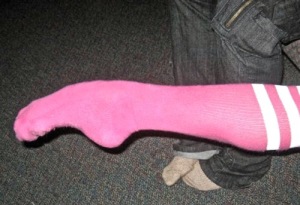
Of course there are trends. American Apparel’s knee-high athletic socks were all the rage to dance in a few years ago, particularly the ones with stripes. I’ve found many a fun pair of patterned and unusually-colored socks in the men’s section of Uniqlo. They’re a little more slippery than my standard H&M sock, but depending on the floor they can also work. I usually go for a calf-height sock, but if they’re taller, like the men’s socks from Uniqlo, I’ll just fold them over. Hubbard Street is the only place where I’ve worn ankle-height socks, but when they’re dyed just right, they do a great job of continuing the line of the leg. One could argue that ballet shoes and bare feet do similar things for line, but wearing socks enables you to do all the sliding and swooshing around of contemporary choreography while keeping the skin of your feet in one piece.
For a while, even after I had gotten used to dancing in socks in rehearsals, I preferred to take ballet with ballet shoes on. Then I gradually started taking barre in socks and putting shoes on only for center. Then, sometimes, I would forget to change footwear during class. After I had an ankle surgery, I stayed in socks the whole time to make sure I could really feel the alignment of all the bones in my feet on the floor. I thought I would eventually put ballet shoes back on for at least part of class, but after trying a few times I realized I preferred to feel as much of my foot as close to the floor as possible. My feet feel more supple, dexterous and intelligent if they aren’t closed up in a shoe, dealing with leather pads under my toes and fabric bunching up inside.
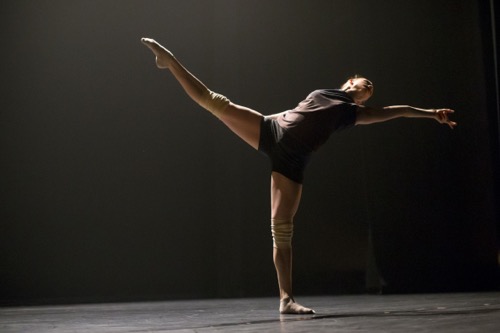
When my feet are free to play the floor in socks, I have a much better sense of where my weight is and I feel like I have access to 100% of my articulation, instead of feeling like I’m dancing in mittens or shoeboxes. And I think similar to the idea of those free-running shoe-gloves, you learn to deal with impact in a totally different way when you don’t have any padding underneath your joints. Jumping in socks was a little scary at first, without having the reassuring leather padding underneath the balls of my feet. But after some practice I found that in order to soften my landings while staying buoyant I was actually informing the entire rest of my body from the information I was getting from my feet. My plié had to adjust and become more sensitive, and my landings and takeoffs have, I believe, benefitted from the new knowledge.
From ballet to floorwork to sliding, slicing and swooshing, socks provide the perfect blend of friction, articulation, and maneuverability and so, no, we contemporary dancers have not forgotten to put on our shoes. We revel in our sockage.
Andrea Thompson and Hubbard Street 2 tour Europe with mixed repertory February 21–March 5, presented by Norddeutsche Konzertdirekton. Performances in Heerlen, the Netherlands; Treviso, Italy; and four cities in Germany will feature recent works by Bryan Arias, Ihsan Rustem, Loni Landon, HS2 Director Terence Marling and Hubbard Street Resident Choreographer Alejandro Cerrudo. For a complete HS2 touring schedule, artist profiles and more, visit hubbardstreetdance.com.
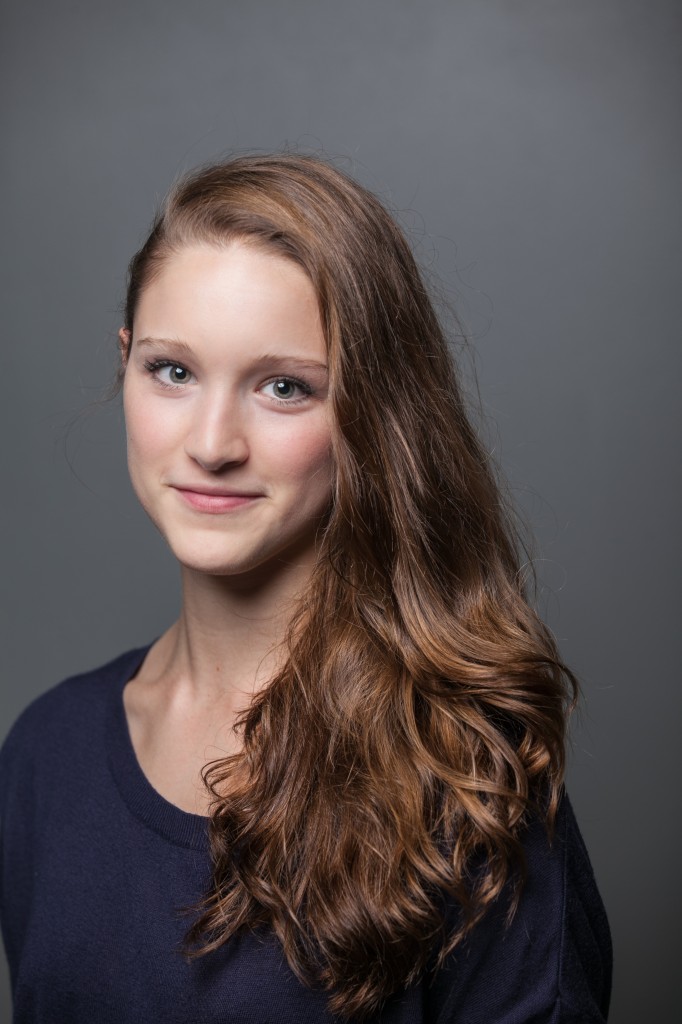
Contributor Andrea Thompson (Maplewood, NJ) trained at the New Jersey School of Ballet, American Ballet Theatre’s Jacqueline Kennedy Onassis School and the Ailey School in New York City. Thompson has also studied at the Juilliard School, Northwest Professional Dance Project, Springboard Danse Montréal, Nederlands Dans Theater and Batsheva Dance Company, which brought opportunities to perform choreography by Gregory Dolbashian, William Forsythe, Natalia Horecna, Jessica Lang, Marina Mascarell, Idan Sharabi, Robyn Mineko Williams, Paul Lightfoot and Sol León. At the San Francisco Conservatory of Dance, under the direction of Summer Lee Rhatigan, she trained with and performed works by Christian Burns, Alex Ketley, Thomas McManus, Robert Moses, Ohad Naharin, Alessio Silvestrin and Bobbi Jene Smith. Thompson joined Hubbard Street 2 in August 2013, following work in San Francisco and New York with Zhukov Dance Theatre, Chang Yong Sung, LoudHoundMovement, Backwoods Dance Project and the Foundry.





Thanks for this explanation of the sock trend in dance. As an audience member I found colorful socks in performance, at first cute. Then, as the trend continued, I found it annoying enough that I avoided companies that wore socks in performance. Now, after reading this, I’m trying for acceptance, or at least resignation. So sorry, but I think, as a costume element, it affects the esthetic. So I prefer skin tone….
Hi Susan! Thanks for the comment. I’m from another time-period in dance, so it has been an adjustment for me to see this as well! Should be interesting to see where things go from here…all best to you!